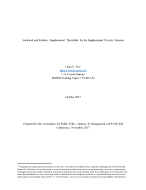
An official website of the United States government
Here’s how you know
Official websites use .gov
A .gov website belongs to an official government organization in the United States.
Secure .gov websites use HTTPS
A lock (
) or https:// means you’ve safely connected to the .gov website. Share sensitive information only on official, secure websites.
-
//
- Census.gov /
- Library /
- Census Working Papers /
- Anchored and Relative: Supplemental Thresholds for the SPM
Anchored and Relative: Supplemental Thresholds for the SPM
Anchored and Relative: Supplemental Thresholds for the SPM
Introduction
Following decades of research, the Supplemental Poverty Measure (SPM) was developed in 2011 by the U.S. Census Bureau and Bureau of Labor Statistics (BLS), as an improvement to the official poverty measure. The SPM incorporates a more inclusive family definition, including additional resources (adding non-cash benefits and subtracting necessary expenses), as well as developing a quasi-relative poverty threshold adjusted geographically and by housing tenure status (renters and owners with and without a mortgage). Many researchers and practitioners have asked for alternative specifications of this threshold, with some researchers preferring an absolute threshold to allow better comparisons to the official poverty measure and others asking for a relative threshold to allow for international comparisons. This paper details the conceptual differences among relative, quasi-relative, and anchored poverty thresholds. This paper also develops and implements a series of anchored and relative thresholds and explores the impact of these alternatives on SPM poverty rates from 2009-2016. Finally, all taxes and government transfers captured in the SPM are subtracted from resources to assess the total impact of taxes and transfers on poverty rates.
Share
Related Information
WORKING PAPER
Supplemental Poverty Measure Working PapersSome content on this site is available in several different electronic formats. Some of the files may require a plug-in or additional software to view.
 Yes
Yes
 No
NoComments or suggestions?


Top

